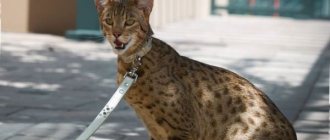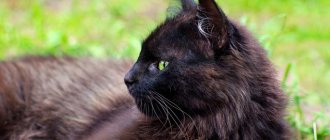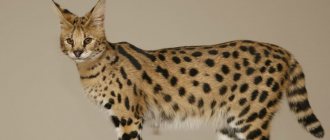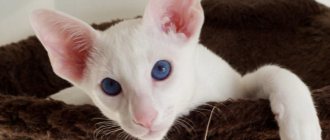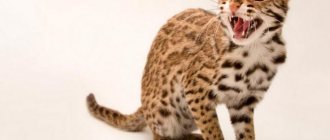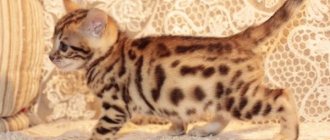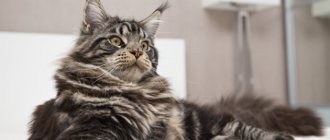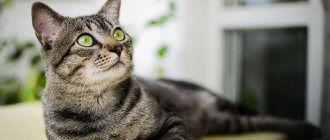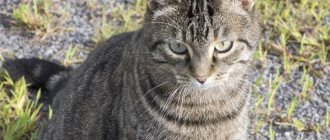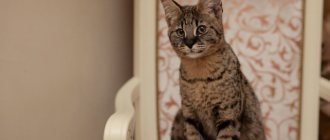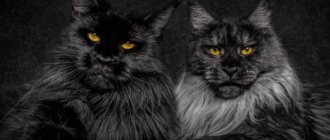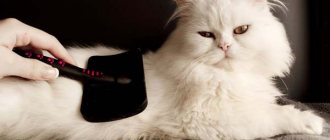Video
* We invite you to watch a video about the Savannah . In fact, in front of you is a playlist in which you can select and watch any of 20 videos about a given cat breed by simply clicking on the button in the upper right corner of the window. In addition, the material contains quite a lot of photos. By looking at them you can find out what Savannah looks like.
In this article:
|
Rate the material!
[Total votes: 3 Average: 4.7]
The Savannah is a hybrid cat that is a slightly smaller version of the cheetah. Its price is off the charts and can sometimes be equal to the price of a one-room apartment. This cat breed is at the top of the list of the most expensive pets and, to some extent, is an indicator of the success of its owner. For this reason, you rarely see this spotted cat on the street.
Health
These cats are distinguished by good health without any specific genetic diseases characteristic of some other breeds. Problems common to all domestic cats are easily avoided and can be resolved by following a vaccination schedule. If the cat has a proper and balanced diet, is provided with proper care and timely veterinary examinations, then no problems should arise.
Males up to the F5 generation are infertile; exceptions are very rare in males of the F4 generation.
Until the F5 generation, males are highly prized due to their impressive size and beauty, but they are kept as ordinary pets. After the fourth generation, cats can already participate in exhibitions, demonstrate themselves and compare with other breeds.
Savannah kitten
History of the origin of savannas
cat breed was created as a result of an accidental cross between a Serval and a domestic cat in 1986 in the United States. Here is how it was. One fairly well-known breeder in her circles, Judy Frank, who had been breeding bush cats for a long time, decided to “renew the blood” of her pets and took a male serval from her friend for mating. Everything turned out great for the animal, but along with the purebred cats, the serval also covered the breeder’s domestic cat.
Judy gave the only kitten that was born after an unauthorized mating to Susie Woods, the same friend who borrowed the serval, as a thank you. By the way, it was she who gave the kitten the nickname Savannah. Susie herself was not a professional breeder, which, however, did not stop her from conducting an experiment on crossing Savannah with her domestic cat and even writing several articles on this topic.
Experiments are experiments, but the main contribution to the development of the breed was made by another person - Patrick Kelly. A man who had long been interested in exotic cats purchased a kitten from Susie Woods and attracted an experienced breeder of Bengal cats, Joyce Sroufe, to breed the new breed. After a decade of painstaking work, in 1996 they presented the International Cat Association (TICA) with new unusual animals with a unique leopard color.
The Savannah breed was officially registered and recognized in 2001. As for the breeder Joyce Sroufe, she received the status of the founder of an elite cat “clan” and world fame.
Interesting Facts
Although savannas appeared relatively recently, a lot of interesting things have already happened to them:
- F1 generation cats were involved in a scam. A fraudster named Simon Brodie was passing off the hybrids as members of a new Asher breed. However, the legend about the unique cats, which were obtained as a result of complex genetic experiments by crossing African servals, domestic cats and leopard cats, was refuted by Pennsylvania breeder Chris Shirk. He stated that employees of the Lifestyle Pets company purchased several Savannahs from him and began to pass them off as a new breed. Subsequently, Shirk's words were confirmed by scientific tests by independent geneticists from the Netherlands. Their results showed that all the cats purchased from Lifestyle Pets agents were indeed Savannah cats.
- At the initial stage, to obtain hybrids, servals were crossed with Siamese, Orientals, Bengals, Ocicats, Egyptian Mau and Serengeti. But in 2012, TICA banned such matings. From that moment on, only crossings of two savannahs or a serval with a savannah are allowed.
- To determine the number of generations separating a representative of a breed from a wild ancestor, special terminology is used. Each generation of hybrids is marked with the letter F followed by a serial number. Representatives of the F1 generation have 50% Serval blood. Second generation hybrids (F2) have about 30% of the bush cat genes. Representatives of the third generation (F3) have no more than 13% wild blood. Hybrids F4...F8 are not recognized by the international association TICA.
- Savannah cats are fertile from the first generation. But the males of the hybrid are sterile until the fifth generation.
Savannah - description of the breed
When starting to describe the savannah, it is worth noting that felinologists have developed three conventional levels of the breed - F1, F2, F3. It follows from this that Savannah F1 is the level that is considered the most purebred and, accordingly, the most expensive (offspring obtained by crossing a serval and a domestic cat). Savannah F2 is the second hybrid generation (offspring obtained from crossing Savannah F1 with a domestic cat). Savannah F3 is the third hybrid generation (offspring obtained from Savannah F2 and a domestic cat).
In the first case, the number of serval and domestic cat genes is 50/50 percent, in the second 30/70 percent, in the third - 13/87 percent. There may also be lower levels - F4, F5, F6, F7, F8, but only the first three are recognized by breeders and felinologists, since they believe that the Savannah generation ends there.
The cat is quite tall on its legs, and its body is much longer and more graceful than that of most domestic cats. The limbs are very long and muscular. The feet are usually oval in shape, with the front feet generally shorter than the back feet. The toes are quite large and the nails are long and hard.
The tail is of medium length and thickness, starting from the hock joint, slightly tapering from the base to the end. The Savannah's physique gives the illusion of great weight, but its weight can be either 5 kg or 12 kg, which depends on gender and age.
The color is usually silver, brown, smoky with darker contrasting oval or round spots, like leopards. In the area of the head and shoulder blades there are parallel dark pigment stripes.
The coat is short, dense, smooth, rough. The head is wide and rather long, with a triangular muzzle, elongated nose and small chin. The eyes are large, close-set, almond-shaped, usually with a drooping upper eyelid. The breed standard allows iris colors of all shades of brown, green and yellow. The ears are high, exactly the same as those of a serval.
Brief history of the breed
The serval or bush cat is a wild feline native to Africa. Since the times of Ancient Egypt, people have known that the serval is easily tamed. These cats were used for hunting and not all classes could keep them. Servals could even then emphasize the high status of their owner.
At the moment, servals continue to be found as pets, but keeping them is associated with a number of difficulties. First of all, this is explained by the fact that the serval was and remains a wild animal, which means that not everyone can become its owner - such a pet will bring much more problems than an ordinary domestic cat.
In 1986, a female Siamese cat was added to one of these “domestic” servals. The couple brought fertile offspring, which gave rise to the emergence of a new hybrid breed. This is how the first savannah appeared in the world (the English name of the breed is “Savannah”). In 2001, hybrids were allowed for registration, but work on the final formation of the breed is still ongoing. Breeders aim not only to create a breed of domestic cat that would phenotypically resemble its wild ancestor as much as possible, but also have a calm temperament and an easy-going nature of a domestic cat. Interest in the breed is growing every year. But why are Savannah cats so remarkable?
Serval - spotted predator
Popular savannah colors
As already mentioned, the coat of the savannah is quite short with somewhat harsh and coarse guard hairs and a shorter and softer undercoat. In areas where the spots are located, the hairs are usually slightly longer and softer.
In the savannah there are only four main colors:
- Brown;
- Tabby spotted;
- Smokey black;
- Spotted silver.
At the same time, the standard shades of spots of the characteristic “leopard print” are dark brown and black. The presence of spots of other colors is strictly prohibited and is a reason for the concept of disqualification.
The shape of the spots is much preferable to oval, somewhat elongated, although rounded is quite acceptable, but their outline must be graphic and clear. The spots in the area of the back are usually larger, and in the area of the chest, legs and head - smaller. There must also be parallel contrasting stripes running from the back of the head to the shoulder blades.
Also, the color and appearance of the savannah depends on what level a particular individual belongs to. For example, F1 hybrids are most similar to servals and have the same large size. F2 hybrids will already be smaller, and F3 savannahs will be even smaller.
Savannahs are most often disqualified for incorrect behavior (too aggressive, or, conversely, too cowardly, unwilling to make contact), rather than for other defects. Congenital defects of savannahs (color defects, rosette spots, medallion spots, small ears, extra toes) also do not go unnoticed, but experts are more loyal to them.
What is the difference between a Savannah and a Bengal cat?
There are differences between these breeds. First of all, the Bengal cat comes from the Far Eastern cat, and the Savannah cat comes from the African serval, and the difference in appearance is corresponding.
Although both skins are covered with beautiful, dark spots, the spots of the Bengal cat are of three colors, the so-called rosettes, while in the savannah they are monochromatic.
There are also physical differences. The Bengal cat has a compact body, like a wrestler or American football player, with small ears and large, round eyes. Whereas Savannah is a tall basketball player with big ears.
Character and habits of savannahs
If you believe the advertising, then the genes of the wild African relative of the savannah (serval) awaken quite rarely in these cats. Whether one should completely trust such statements is a personal matter for everyone. However, one should not discount the fact that any cats are still predators, and savannahs (for well-known reasons) are doubly predators.
Interesting fact: As experience shows, Savannahs are usually quite friendly pets, but at the same time very playful and active. Therefore, these cats are definitely not suitable for owners who see them only as sofa cushions.
One of the most important qualities of the Savannah is the passion for dominance. This trait was inherited by them from their wild ancestors and was somewhat softened by the admixture of the blood of domestic cats. It is worth noting that this passion can be successfully neutralized by sterilization. It has long been noted that cats after this operation become much more tolerant and calmer. This is especially true for individuals of the F1 and F2 levels. Therefore, F3 or F4 hybrids are better suited for a family with children. For owners who want to caress and cuddle their pet, the latter are also better suited.
Savannah cats do not like loneliness, so it is not advisable to leave them alone for a long time. Unless, of course, the potential owner is afraid of the prospect of one day returning to a completely destroyed home with scratched walls and damaged furniture. Savannahs are also often vindictive, so it is advisable to treat them much more respectfully than other cat breeds.
F1 level cats have a rather negative attitude towards strangers, which is most often warned about by loud grumbling and hissing. In relations with the owner, Serval genes are not so pronounced. A few more very characteristic features of the savannah: the choice of one owner, the dog’s loyalty to him and almost complete disregard for other family members.
Savannah Health
Possible diseases
From the wild relative of the serval, the cats received not only an unusual appearance and physical characteristics, but also excellent health. Unlike other cats that are the result of artificial selection, Savannah cats are not susceptible to genetic diseases. And thanks to timely comprehensive vaccinations and regular use of remedies against intestinal and external parasites, there have been virtually no recorded cases of pets becoming infected with dangerous infectious diseases.
Infrequently, an animal may be susceptible to diseases that have a bacterial or viral basis. At the same time, the cat becomes lethargic, loses interest in games, and its fur begins to shed profusely. The animal will lose its appetite and may experience vomiting, diarrhea, or increased urination. Such symptoms serve as a signal that something is wrong with your health: you should immediately seek advice from a veterinary clinic.
Reproductive health
The hybrid component of the breed makes them difficult to reproduce. For example, males from the F1 to F4 generation are completely sterile, but must be castrated.
Male F5 hybrids can be bred to cats. Breeders conduct their mating with a Bengal cat, an Egyptian Mau or with outbred brides.
Due to physiological characteristics, Savannah boys become fully sexually mature by the age of one and a half years. From this age you can choose a partner for them. Females from the age of 2 are capable of reproducing healthy offspring. It is not advisable to mate before this age. The kittens will be born unviable, and the female will slow down her physical development.
The health of the savannah directly depends not only on maintenance and nutrition, but also on the implementation of the sexual instinct. If the owner does not want the cat to reproduce, it should be sterilized.
Interesting facts about savannahs
Savannahs are very active cats. They will almost never lie on the sofa, because they love to run and jump. For this reason, they simply need a play corner and a large number of toys. Otherwise, walls, curtains and furniture may be seriously damaged.
Ashers are not at all afraid of water. They swim and play in ponds with great pleasure. Savannahs are very independent and proud cats. They do not like to be petted, hugged or squeezed for a long time. Individuals of the F1 level are especially intolerant of affection.
These cats become very attached to their owner, choose one for life and demonstrate their loyalty to him in every possible way. F1 hybrids are the most difficult to train because they are half serval. It is best to keep such savannas in a private house in a special enclosure, and not in an apartment.
As for training, Ushers are quite smart and intelligent in order to understand and execute commands intended for dogs (“fetch”, “come to me”, “sit”, etc.).
Thanks to the serval genes, savannahs are excellent hunters, literally one of the best. For this reason, they can sometimes hone their hunting skills on their owner and other family members. It is advisable to wean your pet from this harmful and rather dangerous habit from a young age with frequent walks, games and the acquisition of a sufficient number of different toys.
Savannah kittens not intended for breeding are usually sterilized by breeders in nurseries before the sale takes place. This is done in order to minimize the risk from the somewhat wild nature of this breed.
Savannah character
The character of the savannah, despite its wild roots, is calm and balanced. She is characterized by playfulness, great intelligence and curiosity. Reviews from owners speak of the canine fidelity of their pets.
The mustachioed giants happily walk with their owner, and they tolerate walks on the street on a leash very well. Love for a person makes it difficult to leave a cat for a long time without company. The animal will be very sad, may lose appetite or become depressed. Therefore, the breed is not suitable for people who often leave home.
In general, Savannahs are quite sociable, do not hide at the sight of a stranger, and easily make contact. However, there are some individuals who genetically do not like strangers. They begin to hiss when a stranger approaches. This behavior can be corrected with proper education.
Most Ashers will easily make friends with other animals, or at least live quietly with them. Representatives of the breed treat children good-naturedly, even tolerate their affection and games, but not for too long. They will not offend the baby, they will simply try to run away and hide from the naughty boy.
In addition to the fact that wild beauties are very inquisitive, they love to jump high, easily ending up on a cabinet, refrigerator, or door. From there it is easy for them to observe everything that happens in the apartment or house.
Savannah differs from other representatives of the cat family in its love of water. She takes water procedures with great pleasure, and also has fun pulling out various objects from the bath.
A special feature of the cat is its unusual way of communication. She makes sounds similar to the squeaking and hissing of a snake. This is how, in the wild, a serval scares away an enemy in a moment of danger.
You can't get an Asher kitten without knowing its temperament. Savannah is very independent and will not obey unless she wants to. Her sharp claws and teeth are dangerous to those who try to force what they want from her.
Pros and cons of savannas
The pros and cons of a particular breed are a rather subjective phenomenon, but undoubtedly worth familiarizing yourself with them in detail and remembering all the most important points.
Advantages:
- Exotic appearance and beauty;
- Curiosity;
- Mind;
- Intelligence;
- Almost dog-like devotion to one master;
- Ability to learn and train;
- Strong immunity;
- Get along well with other pets;
- Easy to care for;
- Undemanding to nutrition;
- Quick adaptation to new living conditions.
Flaws:
- Large size;
- Proud and self-willed character;
- Expensive;
- Activity and mobility;
- The need for daily long walks;
- Hazardous to very young children.
To maintain health and active muscle tone, Savannahs are highly recommended for daily walks in the fresh air, especially if the pet lives in an apartment. After all, only on the street will the animal have the opportunity to run, jump, play and thus throw out excess energy. In the warm season, savannas are not at all averse to swimming and frolicking in bodies of water, which is not so typical of the cat family.
As for maintenance, savannas (especially F1 hybrids) feel much better in a country house than in an apartment on some floor. In general, it is ideal if the animal lives in a special enclosure. It’s clear that not every owner has a country house, so you can arrange a special play area for your pet in the apartment. Moreover, in pet stores you can choose one to suit every taste and budget.
Education and physical activity
Savannahs are temperamental and energetic cats that need exercise. They love to swim, jump and roam outside the house. To maintain good shape and muscle tone, hybrids are provided with a sports corner and regular outdoor games.
Representatives of the breed are smart enough to easily remember the rules of “cat etiquette” and learn a few basic commands. True, in the process of training first-generation hybrids, due to the presence of a large amount of Serval blood, some difficulties may arise.
Savanna breeding
The owner of a Savannah cat planning to breed should know that all males of the breed of generations F1 - F4 are sterile, that is, incapable of reproduction or infertile. For this reason, Savannah breeding occurs exclusively on the maternal side by mating cats of the F1 - F3 levels with male African Servals.
Males of the F5 level are already quite capable of reproducing, but the purity of the breed does not benefit from this, but quite the opposite, especially since such offspring will no longer correspond to the generally accepted breed standard.
Sexual maturity in Savannahs usually occurs at 7–9 months, but when planning breeding it is better to wait until the cat is 12 months old. It is clear that the cat must be completely healthy and strong in order to bear and give birth to babies without problems.
Mating of this breed should be carried out only under the supervision of specialists from a specialized nursery. According to the rules of most clubs, before mating, a cat is given a so-called “breeding grade” at a show. The rating must be at least “Very Good”. Cats with the title “Breed Champion” and above do not need to visit an exhibition before mating.
It is also important to know that there are not many savanna species in the world yet. For this reason, breeders had no other choice but to crossbreed animals that were essentially close relatives to each other. This fact, from a genetic point of view, suggests the possibility of many genetic diseases in the breed, but this did not happen. It is difficult to name the reason here; it is possible that the wild blood of the serval did its job.
Interesting fact: There are actually not many nurseries in the world offering to purchase Savannah kittens. For this reason, when purchasing a kitten from a private breeder, its owner is unlikely to receive adequate guarantees of the quality of the breed.
Today, the highest quality Asher gene pool is offered by the A1 SAVANNAHS nursery in the USA, which was organized by Joyce Sroufe.
There are only four specialized nurseries in the post-Soviet space:
- "Savannah Premium" (St. Petersburg);
- "L'unicorne" (Moscow);
- "Royal Cats", "Luxury Cats" (Kyiv).
Savannah cats
Savannah is a rare and very expensive short-haired cat breed.
This breed is right for you if:
- you want a cat with the character and habits of a dog,
- ready to train a kitten,
- you want to get a large, active and intelligent long-living cat,
- Do you want to have several cats or a cat and a dog at once?
- you are not afraid to keep a very active jumping cat at home and you have enough space for this,
- you do not have small children under 4-5 years old.
HISTORY OF THE BREED
The goal of breeding this breed was to create a cat that could replace wild servals for exotic lovers. It took breeders more than ten years to get a smaller copy of the animal - the Savannah cat breed. The parents of the kittens, born in 1986, were a Serval and a Siamese cat. These were the very first kittens of the new breed. It took another 15 years to improve its qualities. In 2001, Savannah was officially recognized and registered by TICA.
Savannah Breeding Process
Savannah is considered one of the rarest and most expensive cats. This is due to the fact that breeding a breed is a very complex process. Observation and care of pets can only be carried out by experienced specialists. You need to love animals, know their character and behavioral habits. Good conditions must be created for animals in the nursery.
The serval is much larger than the domestic cat. To avoid problems during mating, a potential cat-serval pair is raised together from childhood so that the cat can get used to the wild beauty.
Each generation of kittens is assigned an index F. Next to the index is a number. The higher the number, the less the cat resembles a serval and the less blood of a wild predator is contained in its blood:
- F1 (first generation): the animal’s blood contains 53% Serval blood;
- F2 (second generation): the animal’s blood contains 30% Serval blood.
Since Savannah cats are sterile up to the 4th generation, Savannah cats F1 and F2 are used to obtain the next generations, up to F5. They are crossed with cats of one of the following breeds: Bengal, Oriental, Siamese, Egyptian Mau.
FEATURES OF THE SAVANNAH BREED
This is a large, graceful animal with a noble posture and exotic coat color. The largest animals are the F1 and F2 generations.
The length of an adult animal is 1.3 m, height is 50-60 cm, and weight is about 14 kg.
Cats are smaller and lighter. Savannahs reach their maximum size by the age of 3 years. Animals of the F3-F5 generations are smaller in size and body weight.
BODY STRUCTURE:
Savannah has strong bones and well-developed muscles.
The body is elegant, elongated, somewhat rounded. The animal's shoulders and hips are very strong, slightly massive relative to the body. The limbs are slender and strong.
The hind legs are slightly longer than the front legs. The paws are soft, with small toes. Thanks to the structure of the torso and limbs, Savannahs move quickly and silently, and can also jump up to 3.5 meters in height. The tail is of medium thickness and length (should not reach the floor), tapering towards the end. The tip of the tail is rounded.
The chest is strong and deep.
The neck is graceful and thin, with a nobly set head. This makes the animal’s posture seem “royal.”
The shape of the head is triangular. Its dimensions are proportional to the body.
Highly set, large and mobile ears. Wide at the base, rounded at the tips. This shape of the ears provides the animal with exceptional hearing. Soft transition from forehead to nose.
Nose
wide (when viewed from the front) with a barely lowered lobe.
eyes of striking beauty are yellow, green or copper in color.
Wool
- short, thick and soft. It has a gorgeous spotted color. What color the Savannah’s “fur coat” will be depends on what breed of cat the serval was crossed with.
According to the standard ,
the main color of the Savannah should be: silver, golden, brown, chocolate or tabby cinnamon.
The spots are oval and elongated, from dark brown to black. Patterns of spots extend from the back down the entire length of the body. There are smaller spots on the face, paws and neck. The tail has stripes and the tip is black.
Ears
The animal has light spots on the outside.
The inside of the ears is evenly pubescent. lips
, regardless of color, must be black. The expressive look is emphasized by a small droplet-shaped mark of a dark color.
Disqualification of a Savannah cat:
- brindle color, the presence of spots of various colors and sizes; - small ears; - short body; - polydactyly (polydactyly), etc.
CHARACTER OF THE SAVANNAH CAT
Behind the appearance of a wild animal lies a smart, kind, sociable friend. In relation to people, he is more like a dog than a cat. Often the “catdog” waits for its owners near the door. Or he starts following them from room to room. Among all the household members, Savannah chooses one or two owners, to whom she becomes faithful and devoted, like a dog. If it is given to new owners, it has difficulty getting used to them and it is very difficult to tolerate separation from its previous owners. Therefore, getting a pet in order to then give it to someone else’s house is not recommended.
The pet will not be sad if it is left alone in the house. He will always find something to do and will certainly “put things in order” before the owners arrive.
The animal loves to be talked to. In response, he begins to “tweet” gently. Communication with Savannah is one of the important moments in education.
In general, the character and behavior of a pet depend entirely on the owners. Only with proper upbringing will a smart and kind animal grow up.
MAINTENANCE AND CARE
1 A cat settles equally well both in a country house and in a city apartment. One important condition is that Savannah needs space. Given the exceptional jumping ability of the cat, the fences in the yard of the house should be quite high.
2 Savannah doesn't like the cold. After all, its close relative, the serval, lives in Africa, and, as you know, there is no frost there.
3 Savannah cat loves water. You can periodically take your pet to the lake for a swim. At home, Savannah will take a bath or swim in the pool with great pleasure. You can throw various toys into the water, the cat will be happy to “drown” them with its paw. During precipitation, the pet will certainly climb all the puddles in the yard, and then, dirty and happy, lie down somewhere on a chair. Therefore, when it rains, it is better to keep Savannah indoors.
4 Just like the serval, Savannah loves to watch everything that happens from above. Therefore, it is not surprising if your pet falls apart somewhere on the refrigerator or on the mezzanine. You just need to remove all breakable objects away - the animal, if it drops them, can be injured by the fragments.
Caring for Savannah
the same as for an ordinary cat.
- Bath approximately once every two months.
- Monitor the cleanliness and condition of ears, eyes, and claws.
- During shedding, brush the coat every day with a special brush. The rest of the time, it is enough to wipe the animal’s “fur coat” with a damp cloth.
The kitten quickly remembers where the tray is. Easily gets used to it. For a small kitten, a regular cat litter box will do. An adult pet needs a large tray measuring at least 100x60 cm. The filler is only good quality, wood.
Walking and training Savannah
This breed of cat quickly gets used to the leash, but during a walk it is not recommended to remove it - the animal, sensing freedom, will run away. The pet knows how to ask its owner to go out for a walk with it: to do this, just bring a leash in your teeth.
Loves long, active walks in the fresh air, somewhere in the forest or park. Like a dog, he loves playing ball and fetch. When walking a cat, you need to let it run and jump as much as possible. Games and training should be alternated.
Savannah is a highly intelligent animal, very smart and quick-witted. Easy to learn commands. You should start raising a pet from early childhood.
Toys
Toys for Savannah should be chosen as large as for dogs. Small parts may be swallowed by a cat. You should also monitor your kitten during the period of teeth change. At this time, Savannah can chew on wires, poisonous plants, and interior items.
RELATIONSHIP OF THE SAVANNAH CAT WITH PEOPLE AND ANIMALS
Savannah cat's relationship with children
If the family has children over 4 years old, keeping Savannah is possible. At the same time, you need to explain to the baby that this is a kind animal and cannot be beaten. After all, a pet can easily fight back. Having made friends with the child, Savannah will become a wonderful friend, with whom she will run around the house and play all the children's games.
Attitude towards strangers
Treats strangers with suspicion. But as soon as he notices that these are friends of the owners, all distrust disappears.
Savannah and pets
Savannah is, first of all, a hunter. This should not be forgotten if the house contains birds and small rodents. For a pet, they are game that needs to be caught.
As for dogs or cats, Savannah will certainly make friends with them. It is best if pets are of the same age and have lived together since childhood. Pets willingly yield to Savannah the role of leader of the “pack.”
If the house contains both cats and dogs, the descendant of the serval will certainly choose a dog for communication. It’s more interesting with her, because during games an ordinary cat gets tired faster than a dog. Savannah's activity and cheerful character can only be envied.
Savannah reaches sexual maturity at 18-24 months. During this period, you should be patient, as the animal can behave quite aggressively. In addition, Savannah begins to mark her territory. Therefore, it is better to castrate (sterilize) your pet.
Savannah's aggressive behavior
When kittens first come into the house, their reaction to the new environment is fear and hissing. But very soon they are replaced by curiosity. The kitten begins to get acquainted with the house and its inhabitants - this process is very funny!
F1 and F2 kittens have a more wild and independent character; in subsequent generations, the character is no different from the character of an ordinary cat.
At 3 months of age, all kittens are tested for their relationship to humans. If the animal behaves aggressively, it is euthanized. An adult Savannah will never attack first. This can only happen if the animal is improperly raised and abused.
WHAT TO FEED SAVANNAH CATS?
It is not recommended to give cow's milk to young kittens as it causes intestinal upset. Kids love canned meat and mousses. But my favorite dish is meat minced or cut into small pieces without fat. You can give special treats with taurine (for the heart), carotene, colostrum, and multivitamins.
Food for Savannah kittens:
— Royal Canin Babycat 34 (up to 4 months); — KITTEN instinctive (from 4 to 12 months), etc.
The bulk of an adult Savannah's diet should be raw (fresh and good quality) meat. Sometimes you can give it boiled. This is the most necessary product that increases the life of a pet by 5-10 years. From time to time you can treat Savannah with fish and vegetables (except for those that taste sweet).
You can't feed Savannah
fried, stewed, meat marinated with spices, salt, as well as offal (sausages, etc.).
for a pet at any age :
potatoes, grains, flour and sweets.
Food for adult Savannah cats
suitable with a minimum grain content and only Premium Class:
- Royal Canin; — Josera (Super-Premium); — Go Natural holistic, etc.
Savannah should receive a full range of vitamins and minerals. Giving this or that food should be based on the animal’s taste preferences; they may change over time. It is not recommended to suddenly change your diet.
HEALTH AND DISEASES OF THE SAVANNAH CAT
The Savannah cat is a long-liver. With proper maintenance and care, a pet can live up to 20 years. The animal has excellent health and strong immunity.
A cat is healthy if:
- she has an excellent appetite; - cheerful, active; - does not worry, does not “chirp” for no reason; - the coat is smooth (not matted) and shiny; - ears are clean; - nose is cold and wet; - eyes are clear and clean; - anus without excrement residues.
Savannah diseases
and infections are the same as in ordinary cats:
- Worms. Symptoms: vomiting, diarrhea, the animal stops eating.
- Respiratory diseases. Symptoms: fever, sluggish appetite, runny nose, cough.
- Urinary tract infections. Symptoms: the cat often sits in the tray for a long time, meows and worries. As the disease progresses, the pet cannot go to the toilet.
It is not recommended to treat the animal yourself. If symptoms of disease appear, consult a veterinarian.
Vaccination required
against diseases such as feline epizootic (panleukopenia), rabies, rhinotracheitis. Re-vaccination should be carried out according to the schedule.
HOW MUCH DOES A SAVANNAH CAT COST?
When crossing an F1 Savannah cat with a Serval, kittens are born whose blood contains 80% of the blood of a wild animal. These kittens have the appearance of a serval and the character of a domestic cat. They are the most valuable representatives of the breed and cost more than 20 thousand dollars
.
Savannah kittens F2 and F1 are slightly inferior in price: from 5 to 20 thousand dollars, respectively.
Prices for Savannah F5 - F3 range from 1-5 thousand dollars.
In Russia you can buy a Savannah kitten F1, F2 at a price of 500 thousand rubles. and higher. The average cost of a kitten will be 800 thousand rubles.
Savannah kittens F5, F4, F3 will be cheaper. The cheapest litter can be purchased at the nursery from 150 thousand rubles.
HOW TO BUY A SAVANNAH KITTEN? ASHERA'S CAT - WHAT IS IT? How to avoid scammers
Quite often there are advertisements where Savannah kittens are offered at very low prices. Usually, such a tempting offer hides the sale of outbred cats with a spotted color, or ordinary fraud, the scheme of which is quite simple. After you have left a request on such a site, an “employee” of this nursery will contact you. He offers favorable conditions for purchasing an animal: send part of the amount to prepare documents for the pet. As soon as the funds are transferred, a message is received that everything is ready for sale. But suddenly, “by coincidence,” the batch of animals is detained at customs. And again scammers contact you. This time they are asking for a much larger sum to resolve the issue of delivering Savannah. After the money is transferred, the scammers disappear.
USHER'S CAT
Ashera Project
- the biggest scam in the history of this breed. Simon Brodie and his company Lifestyle Pets have announced the creation of a new breed of hypoallergenic Ashera cats. In fact, Savannah F1 cats were passed off as its representatives. Hundreds of people have become victims of scammers, transferring an advance payment for kittens of a non-existent breed. As a result, none of the clients received either kittens or money. Simon Brodie managed to escape. According to some reports, he settled in Canada under a different name.
1 It is not recommended to buy Savannah kittens from persons who sell animals due to relocation and other circumstances. Typically, such sellers are only chasing profit. They have no experience in Savannah breed breeding, and lack the necessary documents and certificates. The living conditions for the animals are terrible and they are not cared for properly.
2 To find an official nursery engaged in breeding Savannah, you will have to look through hundreds of sites. When you finally find what you were looking for, call. During the call, you need to inquire about the history of the nursery, the availability of the necessary documents, what specialists work there, etc. You can read reviews about this establishment on the Internet.
3 It is advisable to observe the lives of adult animals and kittens in the nursery before purchasing. At the same time, you should very seriously weigh all the pros and cons. After all, Savannah is a friend for more than a dozen years. If everything has been decided, and you need a cat of this particular breed, then you need to contact the nursery staff.
4 There is a waiting list to purchase Savannah kittens. Specialists will help you choose an animal and give detailed advice on the conditions of keeping and caring for it. Managers will write down your details so that when it’s your turn, they will contact you. They will also take a small deposit - these are the rules. You will be notified when the kitten reaches the legal age for sale. By this time, you need to prepare the necessary documents and check if everything is ready in your home for the little fluffy ball.
When purchasing a Savannah cat, you will be given a set of documents:
- contract of sale;
- veterinary passport (international);
- vaccination certificate;
- registration of a CITES permit (Convention on International Trade in Endangered Species of Wild Flora and Fauna);
- American TICA documents (the world's largest feline organization) confirming the kitten's breed;
- documents on microchipping of the animal.
After purchasing, Savannah should be shown to a veterinarian, who will check the animal’s condition and prescribe the necessary vaccinations. It is advisable to find a good specialist in this breed (preferably from the same city or region) who can provide qualified assistance and answer your questions.
From the moment the kitten is in the house, a new life begins for you and for him. And, rest assured, Savannah will definitely respond to affection and care with boundless devotion and love.
And in conclusion, we offer a funny video about friendly Savannah kittens:
Savannah care
A short list of rules that the owner of a savannah will have to follow looks something like this:
- Walk often and a lot;
- Pay a lot of attention;
- Accept the inevitable destruction in your home.
Raising a Savannah cat is also impossible without a scratching post. When purchasing this important cat device, you should definitely take into account the size of the animal, because flimsy and small products intended for the most ordinary cats will not last very long.
Also, before bringing a cheetah kitten into your home, you should take care of the correct trash cans with tight-fitting lids. This is necessary so that very curious savannahs do not rummage through them in search of their cat treasures.
Now let's talk about care. Caring for the Savannah's coat requires minimal attention - brushing once a week, and during the shedding period - daily. However, combing can be replaced by wiping the coat with a damp, alcohol-free cloth.
Asher's claws require regular trimming, otherwise the house is guaranteed to be a complete mess. Cats with an overly capricious character can undergo laser onychectomy (removal of claws on the front paws using special equipment). This procedure is not cheap, but buying new furniture and accessories for your home will be even more expensive.
Interesting fact: Savannahs are bathed infrequently - as needed. For bathing, special cat shampoo or baby soap is usually used.
Savannahs get used to the litter box quite quickly. For smaller hybrids (F4, F5), a classic cat litter box is quite suitable. For larger hybrids (F1, F2, F3) a larger tray will be required. Cats also learn to use the outdoor toilet quite easily and can even learn to use the toilet.
Care and maintenance
Due to its large size and overly active temperament, the F1 Savannah is not suitable for keeping in small apartments. Such a cat will feel comfortable in a separate enclosure or a spacious private house with a fenced yard.
Hygiene procedures
To make the savannah look neat, it is provided with appropriate care:
Grooming
The short coat of the Savannah does not require complex grooming. To maintain a neat appearance, it is enough to comb it weekly with a special brush or wipe it with a damp cloth.
Savannahs love water and tolerate bathing procedures well. But to maintain healthy skin, you need to bathe them no more than once a quarter using shampoos for short-haired cats.
Tray
Savannahs are clean animals that have no problems with toilet training. Like any other cat, they can relieve themselves in a litter tray. But if desired, they can be trained to go to the toilet or go outside.
Savannah diet
The diet of the savannah is usually determined by its origin, since the genes of a wild African predator have endowed it with a special digestive system. For this reason, the diet of such a pet should not contain either fatty fish or pork, as well as cereals and fermented milk products.
The best food for Asherah is raw chicken meat and chicken offal with the addition of raw vegetables (carrots, pumpkin, zucchini). It is worth noting that natural food can significantly extend the life of a pet - by 5 years or even more.
Interesting fact: Despite the “wild” origin of the savannah, many breeders still prefer to feed the savannah “dry”. In this case, the food should only be premium with a very low grain content.
Dry food is selected exclusively in accordance with the weight and age of the cat. It is also important to know that to support the heart, the Savannah needs to be given special vitamins with taurine. You can also buy special treats containing this substance in pet stores.
Special vitamin complexes, canned food and pastes are also sold for kittens and pregnant cats. If your Savannah cat eats dry food, you must ensure that she has constant access to clean water. The water must be changed every day.
An adult Savannah cat is fed no more than 2 times a day (breakfast and dinner). The exception to this rule is pregnant females and kittens under 4 months. Needless to say that regularly overfeeding an animal will not be beneficial at all? After all, in the wild they eat completely out of schedule and move much more than at home.
Character
The character of the Savannah Ashers is quite contradictory. Cats have personality. Due to the gene of wild ancestors, the breed is very energetic and dominant. But despite this, savannahs are quite balanced, calm, love affection and are very playful. They exhibit hunting instincts and enjoy long walks even on a leash. These cats are excellent jumpers and can jump 2.5 meters. Trainable. An important trait is high intelligence. Cats are very sociable and loyal. Some individuals are even friendly with dogs, and some even hiss at strangers. Savannahs are not afraid of water and even dive into it themselves.
Savannahs are excellent jumpers
It has been observed that when greeting, the Savannah fluffs up the base of its tail. Not to be confused with the fluffing of the back and entire tail. This is what cats do when they are afraid, just like all other breeds.
Diseases and health problems
The Savannah breed is characterized by simply remarkable health and immunity. Despite multiple (if not constant) cases of incest during their breeding, cats are completely free of genetic diseases as such. Geneticists and experienced breeders cite the notorious serval roots as an explanation for the reason why these cats have such strong immunity. After all, these wild African predators have been adapted to the harshest conditions since ancient times and survived as best they could, thereby training their genes.
Most of the diseases of these cats concern diseases that are widespread among all other breeds. Moreover, most of them can be easily prevented with regular veterinary examinations and timely vaccinations.
Savannahs also have a slight predisposition to the appearance of congenital external defects, which mainly affect not the health of the pet, but its breed status and the ability to take part in exhibitions. Such defects most often occur due to neglect of a pregnant cat (lack of vitamins, poor diet, etc.) or during childbirth.
Such defects usually include:
- Dwarfism;
- Hydrocephalus;
- Polydactyly;
- Cleft palate.
In very rare cases, animals can contract viral, bacterial or fungal infections. You can tell that something is wrong with your cat by changing its behavior. It follows that excessive shedding, lethargy, poor appetite, vomiting, and very frequent urination are signals that some kind of malfunction has occurred in the pet’s body.
Thanks to the same “wild” genes, savannas are prone to longevity and, with proper nutrition and adequate care, can live up to 20 years.
Tips for choosing a kitten
Buying an Asher kitten is a rather difficult task, despite the fact that today in Russia there are nurseries that breed exotic pets. Before contacting nurseries, you need to find out their reputation. This will help you avoid bumping into scammers who make good money by selling any large spotted babies as Savannahs.
The second important point is that if the owner plans to exhibit the cat at shows, then an animal of class F4 or lower should be purchased. Before purchasing, you should once again familiarize yourself with the breed characteristics of your future pet.
Savannah kittens of the first generations will be large in size. They should have spotted fur, clear eyes, ears, and a soft belly without puffiness. It would not be amiss to study the documents, paying attention to the fact of excluding closely related crosses, due to which the offspring are born weakened and capable of dying for no apparent reason.
Feeding
Caring for a Savannah cat includes providing quality feeding. Recommendations on the composition of the diet and optimal nutrition should be provided by the breeder. As a rule, kittens are fed 3-6 rubles/day, adults - 2-3 rubles/day.
Natural food
In the wild, servals feed on birds, small animals, and sometimes eat vegetables and fruits. A pet should be fed in much the same way. Main components of the diet:
- Meat – veal, rabbit, poultry (turkey, chicken).
- Offal.
- Minced chicken. You can buy frozen day-old chicks and grind them through a meat grinder.
It is not recommended to replace meat with fish. Sometimes you can give tuna and salmon. It is recommended to feed 1 egg once a week. Porridge (oatmeal, rice, buckwheat) is given only occasionally (if well tolerated). The diet also includes:
- vegetables, fruits (sources of fiber),
- sprouts of sprouted cereals,
- vitamin and mineral supplements,
- yeast,
- means that facilitate the removal of hair from the stomach.
Additionally, treats with taurine should be given. This is an amino acid that helps strengthen the immune system and improve the condition of blood vessels. Taurine normalizes the functions of the gastrointestinal tract, kidneys, liver, improves the appearance and quality of the coat.
Contraindicated:
- pork,
- milk,
- dairy products.
Dry food
SuperPremium food is suitable. Pay attention to the composition and give preference to diets containing fewer grains. From time to time you need to feed raw meat.
Breed standard according to TICA (The International Cat Association)
| Head | Small (in proportion to the body). It has the shape of a triangle with equal sides, the apex is the line of the eyebrows, the sides are the lines of the muzzle and cheekbones. |
| Muzzle | Wedge-shaped, vibris pads are not expressed. |
| Ears | Large, set high. The base is wide, the tips are rounded. Light colors are desirable on the outer sides. |
| Eyes | They are located moderately deep. There are bright markings in the form of drops of tears, which are directed from the corners of the eyes to the nose. It is desirable that the eye color be brighter. |
| Body | Elegant. Athletic build. The chest is deep. The croup is small and rounded. |
| Legs | Very long, slender. The front ones are slightly shorter than the rear ones. |
| Tail | Middle length. The color is bright and contrasting. |
| Wool | Slightly rough, elastic. Length from short to medium. The guard hairs are dense, the undercoat is soft. |
| Drawing | The spots are bright, black, dark brown. The shape is oval, elongated. The spots are located in parallel lines that go down the entire length of the body. |
| Flaws | Spots of any shade except black, dark brown. The presence of a white medallion. Small ears. Short stature. Tiger color. The spots are vertically aligned. |
Colors
The color features are clearly visible in the photo of Savannah cats. The standard allows:
- Black uniform (Black). The coat is rich black, the paw pads and nose are black/charcoal black.
- Black Smoke – the coat is smoky black, with outlines of spots.
- Brown or brown spotted (Brown Spotted) - background from dark brown to brownish. The spots are darker. Nose black/brown.
- Silver Spotted – silver background, spots, black nose.
- Tabby – background golden, golden-orange, golden-yellow. The spots are bright. Nose: reddish-brown, red, black with a pink/reddish stripe in the center.
